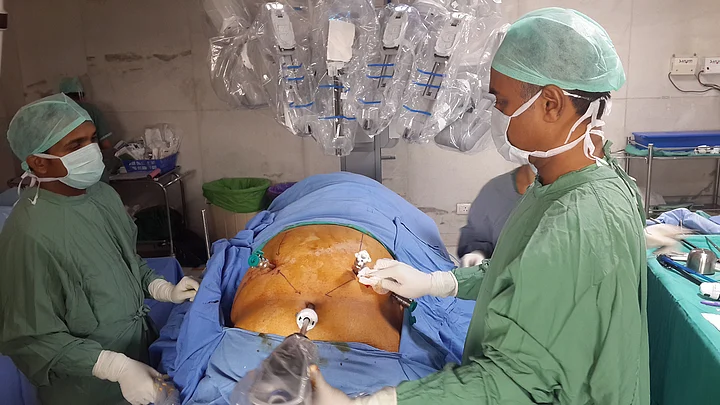Multi-disciplinary robotic surgery has proved its efficacy in India in just five years and it is now time for the government to step in to ensure that it benefits the masses, say top robotic surgeons.
The intervention is needed so that more people can opt for robot-assisted surgeries to treat various medical conditions – including cancer. Such surgeries involve minimal blood loss, quick recovery, shorter hospital stays and a faster return to normal life.
The Centre and state governments must provide robotic surgery units at premier institutions like the All India Institute of Medical Sciences (AIIMS), PGIs and 200 medical colleges across the country so that the benefits reach the needy.Dr Mahendra Bhandari, CEO, Vattikuti Foundation
Vattikuti Foundation is a US-based non-profit promoting robotic surgeries across the world, including in India.
Currently, close to 30 health facilities are performing
high-end robotic surgeries (here, we need to exclude laparoscopic or basic
lithotripsy methods altogether) to treat various complicated health conditions.
190 Robotic Surgeons, Over 4,000 Procedures
Of these, 12 are in north India (including AIIMS, Apollo, Max Hospital, Rajiv Gandhi Cancer Institute, Sir Ganga Ram Hospital, Fortis, Medanta); eight in western India (Jaslok Hospital, Kokilaben Dhirubhai Ambani Hospital, Sir HN Reliance Foundation Hospital, Tata Memorial Hospital); seven in southern India (Apollo Hospital, Chennai and Hyderabad, Krishna Institute of Medical Sciences, Hyderabad, Amrita Institute of Medical Sciences, Kochi, and Aster Medicity, Kochi); and one in Kolkata (Apollo Gleneagles Hospital).
Two more robotic machines are on their way and will be
installed this month – one each in the west and south.

In 2015, nearly 190 robotic surgeons in India performed over 4,000 procedures in the areas of urology, gynaecology, thoracic, paediatric, general surgery, head and neck and bariatric (weight-loss) surgeries.
The government has the responsibility to ensure treatment to people who can’t afford private health care. I do believe that two-fifths of Indians below the poverty line can’t be deprived of medical attention for long.Dr Mahendra Bhandari, CEO, Vattikuti Foundation
Dr Bhandari spent nearly four decades practising cutting-edge medicine in some of the best-run government institutions in India.
The Vattikuti Foundation is behind the Vattikuti Urology
Institute at Henry Ford Hospital in Detroit where Dr Bhandari is working as
director, robotic research and education.
Why Robotic Surgery Preferred Over Traditional
Robotic surgery is preferred over traditional laparoscopic techniques because robots operate in 360-degree mode and can reach difficult-to-access parts – such as stomach blood vessels – with ease. Moreover, robotic suturing is far more accurate, causes less blood loss, sees faster recovery and leaves practically no scars.
Compared to laparoscopic procedures where there are longer hospital stays and over a month-long rest period, those undergoing robotic surgeries are back home in two-three days and return to normal activities within three weeks.Dr Arun Prasad, Surgeon (Institute of Robotic Surgery)

The surgical robot with four arms can reach organs and areas where human fingers can’t. The three-dimensional (3D) view that can be magnified multi-fold helps the surgeons achieve precision that is hard to match.Dr Mahendra Bhandari, CEO, Vattikuti Foundation
The greatest impact has been in cancer surgery; it is now possible to remove tumours from almost any organ in the abdomen or chest with great precision and accuracy while saving normal and healthy tissues.
Patients recover much faster, have significantly less pain and have decreased chances of developing complications as compared to conventional surgery. Dearth of adequately trained and experienced robotic surgeons is a limitation which we have to strive to overcome.Dr Gagan Gautam, Head of Urologic Oncology and Robotic Surgery, Max hospital
The Cost Needs to Come Down
Dr Gautam has performed over 500 robotic procedures since 2011. From 2009 to 2011, he pursued a two-year clinical fellowship in robotic urological cancer surgery at the University of Chicago.
Dr Tarun Mittal, laparoscopic and obesity surgeon at Sir Gangaram Hospital, firmly believes robot-assisted surgeries will only increase in the next three to five years. But it will require government intervention.
The government should make an effort to create awareness among the masses, laying emphasis on the success rates of such surgeries. They can make these robot-assisted surgeries part of the ‘Make in India’ project, making it cost-effective by providing subsidies so that it reaches the common man.Dr Tarun Mittal, laparoscopic and obesity surgeon, Sir Gangaram Hospital
Dr Sanjay Gogoi, director (urology and renal transplant),
Fortis Memorial Research Institute, says that the government should take the
initiative to convince insurance companies to cover robotic surgical
procedures.

“Moreover, it should reduce the duties on imported robotic consumables. This will greatly reduce the cost of the procedures,” Dr Gogoi told IANS.
For Dr Bhandari, robotic surgery in India is already significantly cheaper, when compared to the West. “I do hope that the cost of robotic surgeries will come down further. How soon and by how much the cost will come down is difficult to answer as of now,” he adds.
(Nishant Arora can be contacted at nishant.a@ians.in)
(At The Quint, we question everything. Play an active role in shaping our journalism by becoming a member today.)
